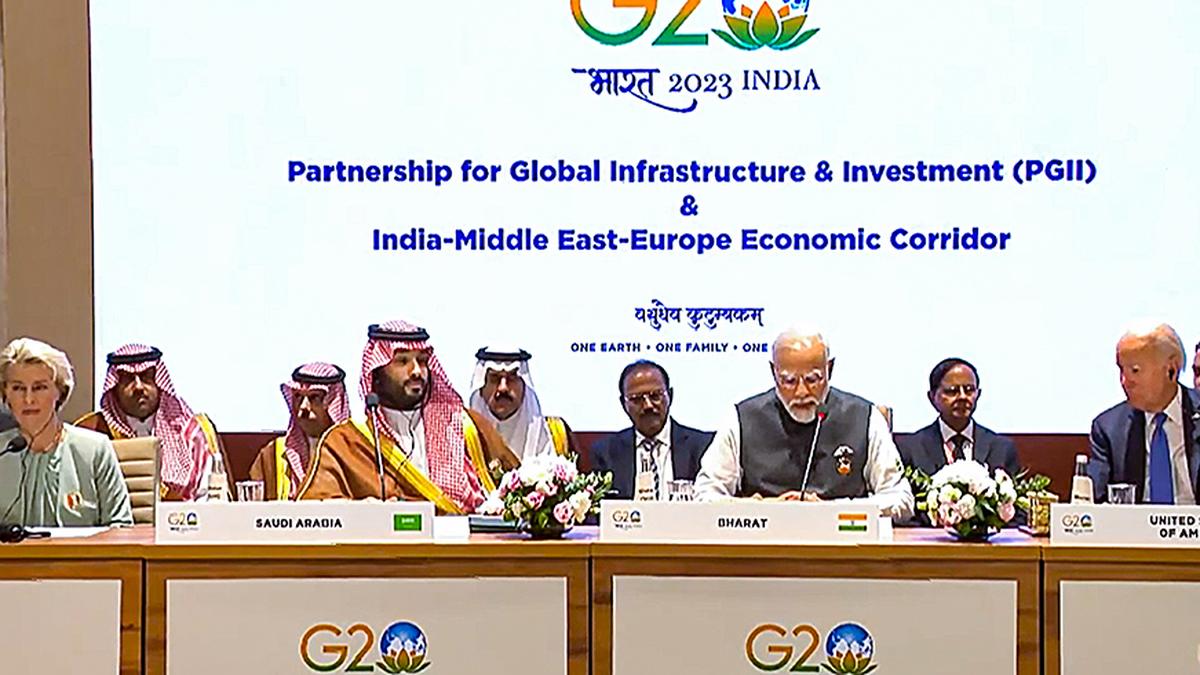
A mixed report card for the India-Middle East-Europe Corridor Premium
The Hindu
Implementation on the northern part of the corridor, which is majorly in West Asia, is going to move slowly until the conflict subsides, while progress is faster on the eastern leg connecting the UAE and Indian ports
In September 2023, the ambitious transcontinental India-Middle East-Europe Corridor (IMEC) was announced on the sidelines of the G20 summit in New Delhi. The proposed corridor is expected to reduce the transit time between its eastern and western nodes by 40%, and costs by 30%, compared to transportation via the Suez Canal. These numbers may vary as the actual benefits may end up being on the lower side, but there is no denying that the new corridor, once operational, will be a game changer for the international maritime trade. Therefore, it is important to understand how the idea has shaped since its announcement and what lies ahead of it.
Over the past year, various challenges have delayed progress on the project. The announcement of the corridor came with much optimism. However, this did not last long, as the very premise which led to the conception of this idea, namely, the normalisation of Arab-Israel relations, came to a sudden halt with the escalation of the conflict between Israel and Palestine on October 7 last year. This crisis engulfed the whole of West Asia for the larger part of the year, which put the corridor on the back-burner. As a result of the temporary pause, two key stakeholders, Saudi Arabia and Jordan, have not been able to make any progress on the project. Though it may be argued that the official relations between Arab countries and Israel won’t impact completion of work on the ground, the two governments, which will have to work closely with the Israeli establishment for the project, would not want the optics and its geopolitical dimension. Therefore, implementation on the northern part of the corridor, which is mostly in West Asia, is going to move slowly until the ongoing escalation subsides.
On the eastern leg of the corridor connecting the United Arab Emirates (UAE) and Indian ports, things are moving forward at a relatively fast pace. The economic relations of the two countries are on a northward trajectory, which is also reflected in the increasing bilateral trade numbers. Post the signing of the Comprehensive Economic Partnership Agreement (CEPA) in 2022, bilateral trade has grown from $43.30 billion in 2020-21 to $83.64 billion in 2023-24 (a staggering 93%). Another important feature of the growing bilateral trade is the diversification of the trade basket between the two countries, which is reflected in the growing non-oil trade. The non-oil trade between India and the UAE grew from $28.67 billion in 2020-21 to $57.81 billion in 2023-24. This represents a healthy shift from an Indian perspective, considering that most of these commodities will be transported further west and north through the IMEC, thereby improving India’s export share in the larger region.
Beyond amplifying trade volumes, the two countries are also working on the standardisation and facilitation of trade processes. Recently, India and the UAE launched the Virtual Trade Corridor. This will be an integral part of the IMEC, aimed at the reduction of administrative processes and time, reduction of logistics and transportation costs, and ease of doing trade. The streamlining of trade processes would not only serve bilateral relations, but also pave the way and provide a working model for other countries involved in the IMEC to develop similar frameworks for cross-border trade facilitation.
After more than a year since the IMEC was announced, we see an uncertain western part of the corridor trying to navigate through the conflict and a committed eastern part that is forging new linkages to ready itself for the new maritime order.
Further, given the one-year progress and the situation on the ground, it is clear that only the connectivity aspect of the IMEC initiative is gaining some traction at the moment. Other elements of the corridor, including clean energy export, undersea fiber-optic cables and pipelines, energy grid linkages, telecommunication lines, and clean energy technology cooperation, will have to wait till the situation in West Asia normalises. Therefore, the countries on the eastern part of the corridor should use this time to develop their capacity to improve connectivity among them.
India, especially, can use this time to prepare its ports, develop specific economic zones along the connectivity nodes, and improve its domestic logistics for seamless integration with the IMEC. There is a need to improve the digital footprint in the domestic logistics landscape, which will help reduce logistics time and costs, thereby making Indian exports more competitive. Further, the corridor, as ambitious as it may be, is just the means. The actual benefits will be seen only if India can improve its integration in the global value chains. With IMEC, India aims to position itself as a global supply chain alternative. This can only happen if the country takes steps towards enhancing its manufacturing competitiveness.











